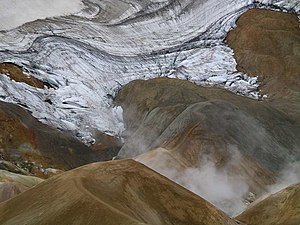Kerlingarfjöll
| Kerlingarfjöll | ||
|---|---|---|
|
Kerlingarfjöll |
||
| height | 1477 m | |
| location | Iceland | |
| Mountains | Kerlingarfjöll | |
| Coordinates | 64 ° 38 '36 " N , 19 ° 13' 38" W | |
|
|
||
| Type | Tabular volcano | |
| rock | predominantly rhyolite | |
| Last eruption | (active) | |
|
Hveradalir high temperature area |
||
The Kerlingarfjöll is a volcanic mountain range in Iceland and reaches a height of 1,477 m with the Snækollur .
The mountains of this mountain range are located in the Icelandic highlands about 25 km east of the Kjölur route.
Presumably they were once part of the Hofsjökull glacier shield .
On the geology of the volcanic system
The Kerlingarfjöll volcanic system covers approx. 100 km 2 .
However, one can also find literature that attributes the system to that of Hofsjökull .
Tabular volcanoes made of rhyolite rock
According to recent research, the Kerlingarfjöll mountains are tabular volcanoes made of rhyolite rock that were formed during eruptions under glaciers. Only at the top are they covered by layers of basalt . Unlike basalt tabular volcanoes such as Herðubreið , water was only involved in the initial phase of the eruption. The transition from the explosive to the effusive eruption phase happened on dry land.
Geologists from Harvard University compared the systems of the Kerlingarfjöll and Prestahnjúkur with rhyolite mountains of the Sierra La Primavera , Mexico . During the subglacial eruptions of the Kerlingarfjöll, fine-grain ash layers were initially formed, later eruption phases produced lapilli - tuff layers by means of pyroclastic currents .
Possible glacier runs during the ice age
The geologist Bergur Einarsson assumes that when the Kerlingarfjöll were still under ice, they probably started out through glaciers during hydromagmatic eruptions . Several researchers at Harvard University disagree . According to them, the eruptions were not of great magnitude. They do not assume glacier runs. In their opinion, the influence of the ice seems to have been more in the hydromagmatic effect, the rupture of the magma.
Hveradalir high temperature area
Today there is a high temperature area in the so-called Hveradalir with numerous hot springs, mud pots , fumaroles and steaming streams.
Former summer ski area
In the Kerlingarfjöll area, on the slopes of Loðmundur , there was a summer ski area from the 1960s to 2000. The climatic changes make skiing impossible there in summer. In winter, however, the area is difficult to access.
Hiking in and around Kerlingarfjöll
Today the huts serve as accommodation for tourists and hikers in summer.
The high valleys of Hveradalir are well developed with hiking trails, some of which, however, require a head for heights.
The mountains Snækollur and Loðmundur can both be climbed from the north side.
There is also a three-day tour from hut to hut around Kerlingarfjöll. The trekking path is 50 km long. It is recommended to walk it counterclockwise. The first stage of the day leads to the southwest to the Kerling rock and from there to the hut on the Klakkur . There are two ways to get from Kerling to the hut. The second stage leads to the Kisubotn hut and past the Klakkur, Grákollur mountains and the Kisugljúfur gorge . The hut is located in the Kisubotn Valley, the extension of the Kisugljúfur Gorge. The third stage leads from there to the north side of Loðmundur and back to the huts at Kerlingarfjöll.
See also
Web links
Kerlingarfjöll in the Global Volcanism Program of the Smithsonian Institution (English)
Photos
Scientific contributions
- On the geology of Kerlingarfjöll, Univ. of Manchester, p.18 (English, PDF file)
- Univ. Harvard: About the Kerlingarfjöll eruptions (English) bibcode : 2007AGUSM.V33B..04S
- Open University: volcanic eruptions under glaciers, including Kerlingarfjöll (English)
- Stephanie Flude, ea: Subglacial rhyolites from Kerlingarfjoll, Iceland. Geochemical evolution and preliminary eruption ages , Nordic Volcanologic Institute, University of Iceland Reports, 0303, Summer School 2003, p.18 (PDF file, abstract, English; 2.5 MB)
Other
- Description (English)
Individual evidence
- ↑ cf. Kerlingarfjöll on the Smithsonian Institution's Global Volcanism Program , accessed October 29, 2010
- ↑ to: Dave McGarvie: Volcanic eruptions into Iceland's Glaciers, Open University (Craven & Pendle Geological Society, Program 2006/2007) http://www.kabrna.com/cpgs/programme/events_06_07.htm#iceland
- ↑ a b A. Stephensen oa: Subglacial Silicic Eruptions. Wet Cavities and Moist Cavities. American Geophysical Union, Spring Meeting 2007. bibcode : 2007AGUSM.V33B..04S .
- ^ Bergur Einarsson: Jökulhlaups in Skaftá. A study of jökulhlaup from the Western Skaftá cauldron in Vatnajökull icecap, Iceland. Univ. of Iceland, 2009, p. 22 (-English, PDF file)
- ↑ cf. z. B. Ari Trausti Guðmundsson, Pétur Þorsteinsson: Íslensk fjöll. Gönguleiðir à 151 tind. Reykjavík 2004, pp. 252 and 196
- ↑ http://pressan.is/ferdapressan/Lesa_Utivist/ny-gonguleid-hringinn-i-kringum-kerlingarfjoll-a-thremur-dogum , accessed on October 3, 2010







